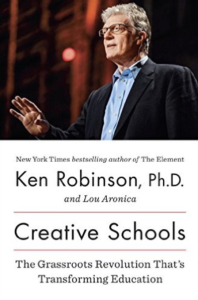 To better serve more students and encourage creativity, inquiry, a diversity of skills, and the ability to live a fulfilling life, we need teachers, principals, and policy makers to charge forward with the revolutionary idea of personalized and holistic learning. Authors Sir Ken Robinson, who delivered a TED talk about creativity and schools that has been viewed more times than any other TED talk, and Lou Aronica make these claims in their new book, Creative Schools: The Grassroots Revolution That’s Transforming Education. After explaining clearly the shortcomings of our current education reform narrative, Robinson and Aronica offer a compelling vision for a new educational system and a theory of change that can be implemented either from outside of or within school systems.
To better serve more students and encourage creativity, inquiry, a diversity of skills, and the ability to live a fulfilling life, we need teachers, principals, and policy makers to charge forward with the revolutionary idea of personalized and holistic learning. Authors Sir Ken Robinson, who delivered a TED talk about creativity and schools that has been viewed more times than any other TED talk, and Lou Aronica make these claims in their new book, Creative Schools: The Grassroots Revolution That’s Transforming Education. After explaining clearly the shortcomings of our current education reform narrative, Robinson and Aronica offer a compelling vision for a new educational system and a theory of change that can be implemented either from outside of or within school systems.
Robinson opines that, since the introduction of the No Child Left Behind legislation, the federal government’s role in education has increased significantly. The current focus, however, on raising standards and accountability is misplaced because the problems can be addressed only by larger scale changes in the type of learning experience we provide to students. The increased amount of standardized testing that accountability measures require of students, for example, is exacerbating our problem of teaching to too narrow a skill set, killing creativity and entrepreneurialism, and leading to the deprofessionalization of the teaching profession.
Robinson urges that, as we think about educating students for the future, we need to face several concerning trends: the decreasing monetary value of a college degree and the rising cost of earning one; a bifurcated academic and vocational class system contributing to rising income inequality; the social and financial drain of having nearly 1.5 million students (who are disproportionately racial minorities) drop out of high school each year; and the boredom and demoralization of those who remain in school.
One way to address these issues, according to Robinson and Aronica, is by shifting our educational system from one modeled after industrial revolution era manufacturing practices to one more analogous to mass farming practices. Doing so would better serve the economic, cultural, social, and personal purposes of education. Our current model has a pyramidal structure in which only a select few students—those who have most successfully conformed to the “student mold”—make it all the way through the educational system to earn advanced degrees. To keep pace with changing economic demands and to foster a wise citizenry that can support a healthy democracy, schools need to: serve the whole student (not just the student-reader, writer, or mathematician) and cultivate his multiple intelligences; recognize the interdependence between students and their community and allow them to pursue their interests in an authentic, self-paced, and playful way; and serve all of its members regardless of their home or financial circumstance.
Robinson and Aronica offer advice for teachers and principals about how they can effect change within the educational system. The core objective of the art of teaching is to facilitate learning, and yet teachers get bogged down in so many extraneous responsibilities. The authors urge teachers to focus on building strong relationships in which they engage their students, enable their students’ curiosity and help them find their passion, maintain high expectations, and empower their students. Principals can help by giving equal weight in the curriculum and culture to subjects like art and physical education, offering opportunities for interdisciplinary learning, and letting students have a voice in decisions about curriculum content while also ensuring that the ideas presented in the curriculum are diverse and taught with depth and dynamism. The strongest leader has a vision and a plan of implementation, but also empowers all members of her community to be innovators who generate ideas for improvement. The authors provide an alliteration of the 8 skills schools should try to promote: curiosity, creativity, criticism, communication, collaboration, compassion, composure, and citizenship.
The authors note also that supporting student learning is not the responsibility solely of the school; it occurs through an interactive partnership among the school, family, and community. Parents, for example, should take a keen interest in their children’s learning while resisting the urge to become overbearing and controlling about school work.
Robinson and Aronica conclude that, even among individuals with good intentions to support educational reform, combatting entrenched thinking about standardization and conformity rather than personalization and creativity is a challenge. They urge reforms to keep students’ enthusiasm for learning at the forefront of their efforts. With a vision for the future, the belief that change is possible, an understanding of why change is good, the resources necessary to catalyze reform, and an action plan, the revolution for which this book cries is eminently possible.
Robinson, K., & Aronica, L. (2015). Creative Schools: The Grassroots Revolution That’s Transforming Education. New York, NY: Viking Penguin.

